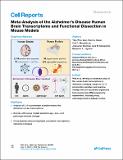Notice
This is not the latest version of this item. The latest version can be found at:https://dspace.mit.edu/handle/1721.1/135985.2
Meta-Analysis of the Alzheimer’s Disease Human Brain Transcriptome and Functional Dissection in Mouse Models
Author(s)
Unknown author
DownloadPublished version (4.086Mb)
Publisher with Creative Commons License
Publisher with Creative Commons License
Creative Commons Attribution
Terms of use
Metadata
Show full item recordAbstract
© 2020 The Authors We present a consensus atlas of the human brain transcriptome in Alzheimer's disease (AD), based on meta-analysis of differential gene expression in 2,114 postmortem samples. We discover 30 brain coexpression modules from seven regions as the major source of AD transcriptional perturbations. We next examine overlap with 251 brain differentially expressed gene sets from mouse models of AD and other neurodegenerative disorders. Human-mouse overlaps highlight responses to amyloid versus tau pathology and reveal age- and sex-dependent expression signatures for disease progression. Human coexpression modules enriched for neuronal and/or microglial genes broadly overlap with mouse models of AD, Huntington's disease, amyotrophic lateral sclerosis, and aging. Other human coexpression modules, including those implicated in proteostasis, are not activated in AD models but rather following other, unexpected genetic manipulations. Our results comprise a cross-species resource, highlighting transcriptional networks altered by human brain pathophysiology and identifying correspondences with mouse models for AD preclinical studies.
Date issued
2020Journal
Cell Reports
Publisher
Elsevier BV